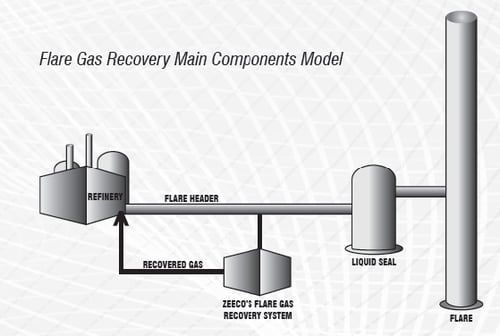High Pressure Air Assist System and Flare Gas Recovery Technology for Continuous Flare Management
CATEGORIES:
Flares are an important safety feature of most oil and gas producing and processing facilities, providing a safe and effective means for burning waste gases during emergency condition. These emergency conditions often coincide with power outages, loss of steam, fire in the plant, or a variety of other scenarios. Flares are also used to safely burn any continuous relief cases that can result from on-going processes, control valve leakage, purge, etc. In recent years, local governments, air quality agencies, environmental groups, and end users have pushed to reduce the amount of continuous flaring. These particular flaring cases are viewed as wasteful, polluting, and potentially hazardous to humans. This paper will discuss several different methods for reducing and/or mitigating the impact of continuous flaring as part of a Flare Impact Mitigation Plan (FIMP).
One of the first steps in any FIMP should be to better understand the continuous flaring sources in a facility. This can be a challenging process, as the local operators may have a tendency to underestimate the amount of continuous flaring that takes place at a facility. A realistic estimate of the continuous flaring must be obtained in order to determine the best and most economical course of action.

Flare Gas Recovery
In cases where the user wants to completely eliminate continuous flaring, the Flare Gas Recovery Unit (FGRU) is the ideal solution. An FGRU is a useful means to reduce the amount of flaring, while still maintaining the proper safety and operations within a facility. Gases that are recovered by an FGRU can be used within the facility to offset fuel gas usage. This provides a net reduction in fuel gas usage as well as an environmental improvement by decreasing CO and hydrocarbon emissions.
In a typical facility (without an FGRU), gases are constantly sent to the flare from a variety of sources. In a facility with an FGRU, the continuous operation bypasses the normal gas flow rates into the FGRU system where they are compressed and sent back into the plant (Figure 5). During these continuous conditions, the only gas being burned at the flare system is the standing pilots, as well as any combustible gas that the customer is using for the flare stack purge. If nitrogen is available, it can be used as a non-combustible purge gas to further reduce flaring. A specially designed liquid seal or staging valve ensures that the smaller, continuous relief cases can be sent to the FGRU, but during emergency reliefs, the gas can still be sent to the flare system for safe burning.
Conclusion
As discussed previously, flares play an important safety role at a facility, providing a safe and effective means for burning waste gases during emergency conditions. However, for continuous flaring conditions, there is a preference for flaring to be mitigated or eliminated. The proper solution for this change should be determined as part of a Flare Impact Mitigation Plan (FIMP).
Download Technical Paper